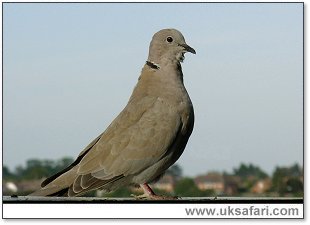
|

|
|
 Sent
to you Sent
to you
by e-mail
|
|
Simply
enter your details and hit the send button
more
info |
|


Click Here

Links
Advertise
Terms of Use
Contributors
About Us
Contact Us
|
 |
Go back
 | Bookmark
| Bookmark
 | Print Page
| Print Page  | E-Mail Us
| E-Mail Us 
Canker in Garden Birds
____________________________________________________
Posted: 13th September
2006

Photo: Andy Meads |
It's been a
bad year for birds suffering from Trichomoniasis, or as it's more commonly
known - 'canker'.
Many people have contacted us describing the symptoms they have seen in a number of species,
especially greenfinches, chaffinches, house sparrows and collared doves. The photo above shows a collared dove displaying
the symptoms of canker. The feathers become fluffed up and the bird gets lethargic. A swollen crop may be visible or signs that the bird has been dribbling and has trouble swallowing.
In later stages the bird will show signs of having difficulty in breathing and
may become emaciated.
Canker is spread mainly via food or drinking water which has been
contaminated with saliva or droppings from an infected bird. If caught in time the disease can be treated with drugs, but once again we can help prevent the spread by good hygene
around bird feeding tables and bird baths. Unlike Salmonella, canker does not affect humans but can cause disease in domestic poultry.
Where there are high densities of pigeons and doves the disease seems more apparent and this year has seen an increase in affected birds.
As the winter migrants return to the UK this autumn the bird flu hype will once again be in the news.
For some people the sign of a sick or dead bird may cause alarm, but the chances of a garden bird carrying H5N1 are almost nil.
Andrew Meads - Safewings

UK Safari News
|
 |

|